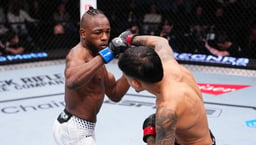
Issue 113
April 2014
There’s no such thing as an off-season in MMA, so here’s an S&C workout to follow all year round
PAUL MCVEIGH
Sports scientist, TUF 14 cast member and full-time coach – each issue he presents his best conditioning tips
In a strength coach’s ideal world, training would be seasonal. You would have the in-season, when competition and skill training is prioritized. And then there would be the off-season when there are no competitions, skill training is at a minimum, and the athlete would work hard to become stronger and faster while preparing for the upcoming in-season period.
MMA and its constituent sports are hugely skill dependant. The early UFC tournaments were popularized by the very fact Royce Gracie was routinely throttling giant super athletes. With there being so many important skills to learn it can be tough to make yourself stop and focus on physical attributes like strength while your technical attributes (at least in your own opinion) regress.
If you are a professional athlete, throwing in an annual or biannual off-season period can break up the monotony of training while leading to performance improvements. But for most of us, we train because we enjoy it and while performance is important we are unlikely to take three months away from skill training. Who wants to go an entire week without punching someone in the head or working on that new takedown you are excited about?
From a strength coach’s perspective the recreational MMA athlete is constantly in season, always skill training and sparring year round. This can make strength development difficult, but not impossible.
To the right is a program I’ve used with many athletes to encourage strength development in parallel to technical improvements.
With all in-season programs, the biggest concern is affecting the athlete’s skill training and sparring. If you have been doing a workout designed for the Bulgarian Olympic lifting team you can expect to find your sparring performance taking a knock. The fatigued athlete is also much more likely to pick up injuries. Scaling the workout so it doesn’t destroy people is very important.
To this end the workouts listed tend to be very short in duration. I can regularly get through each workout in 30 to 45 minutes, usually right after having done some skill-based training or sparring. It might not be the optimal way to do things, but it’s valuable to recognize the importance of consistency and just getting workouts in.
The program shamelessly steals many components from Jim Wendler’s fantastic 5/3/1 workout, with a few tweaks with the MMA athlete in mind.
For the accessory lifts, perform in a super set fashion and do three sets of five to eight reps for each movement.
We begin by establishing the one-repetition maximum (1RM) for each of our main lifts. Those being the squat, deadlift, strict press and the bench press. This 1RM value is then multiplied by 0.9 to give you the training maximum that is 90% of the 1RM. The percentages below will all be based off this training maximum.
By starting with a load based on a value slightly less than 1RM we are further ensuring that the athlete avoids serious fatigue. Similarly, the rep ranges used are higher than those used in the 5/3/1 program, again helping that athlete to skill-train unhindered.
The athlete loads the bar with the weight prescribed and performs the designated number of reps in the first two sets. In the third and final set the athlete performs as many reps as possible (AMRAP) with the prescribed load.
The fourth week is a deload week: the loading is drastically lowered giving the athlete a chance to recover from the
fatigue they have accumulated and sets them up for the next four-week block.
To continue progressing after each four-week block, simply add between 1.25kg and 5kg to your training maximum and repeat the process. You can also vary the type of main lift used, replacing the deadlift with a sumo deadlift or a back squat with a front squat.
Developing strength alongside a schedule filled with skill training can be challenging. Hopefully, the program outlined will enable you to do just that, all year round.
...









